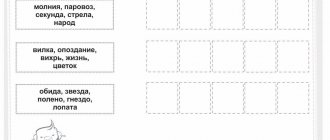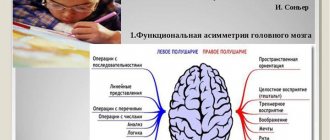Isotherapy in working with preschoolers
Preschool age is the most important period of a person’s life, when basic personal characteristics, worldview, and attitude towards oneself and others are formed. The child actively explores the world and reflects it in his natural activities - play and drawing. The most striking opportunities for children’s self-expression are represented by visual arts.
Modern researchers point to the great role of fine art and play in the formation of the psyche of a child, both normally developing and with disabilities (Medvedeva E.A., Levchenko E.Yu., Smirnova E.O.). In a situation where verbal contacts between children in a group are difficult, isotherapy acts as a means of communication and promotes unity and interaction among children. Expressing himself through drawing, the child gives vent to his feelings, desires, dreams, rebuilds his relationships in various situations and painlessly comes into contact with some frightening, unpleasant, traumatic images. This is especially important in correctional work with neurotic and anxious children.
One cannot but agree with L.D. Lebedeva, who points out that isotherapy creates a positive emotional mood in the group, facilitates the process of communication with peers, strengthens the child’s cultural identity, develops a sense of internal control, promotes creative self-expression, the development of imagination, aesthetic experience and socialization of the child .
In my practical work, I use children’s drawings both in diagnostics and in correctional and developmental work with preschoolers who have problems in the emotional-volitional sphere (high anxiety, aggression, low self-esteem, timidity, shyness). It is in the drawing that not only the level of development of graphic skills and mastery of drawing techniques is reflected, but also the characteristics of intellectual development, personality and character traits, as well as the characteristics of interpersonal relationships. In my opinion, the value of isotherapy lies in the fact that techniques and techniques can be used in individual, subgroup and group work with preschoolers of almost all age groups.
During the 2011-2012 school year, with children of the senior group who have problems in the emotional sphere (high levels of anxiety and aggression, low levels of self-esteem and sociability), individual and subgroup classes were conducted (once a week) using isotherapeutic techniques that help correct aggression , anxiety, sociability. After repeated diagnostics, the results changed: the manifestation of negative emotions decreased, the children’s self-esteem, sociability and optimism increased, and anxiety decreased.
Dear Colleagues! I offer you a series of isotherapeutic techniques aimed at correcting the emotional-volitional sphere of preschool children.
"Colorful sheets"
Goal: improving the elements of self-regulation, training the sequence of actions, extinguishing hyperactivity.
Instructions: the child is asked to paint the sheets of paper one by one (red, yellow, blue, green), and then hang the sheets on the wall in the same sequence, covering one another.
"Drawing with clay"
Goal: stress relief, tactile stimulation, imagination development.
Instructions: invite the child to dip his fingers in clay (finger paints) and draw on paper (plexiglass).
The theme of the drawing may vary.
"Free drawing in a circle"
Goal: harmonization of the emotional state, establishing communication, unification.
Instructions: children are asked to take turns painting roads towards each other in a circle (a large sheet of paper in the shape of a circle)
"Water Fireworks"
Goal: correcting fears, relieving tension, developing imagination
Instructions: ask the child to paint on the water, look at and analyze the resulting shapes.
"Crayons - race"
Goal: correction of aggression, relief of tension, harmonization of emotional state.
Instructions: the child makes strokes on the sheet with crayons at different paces (slow - fast)
"Colorful Pebbles"
Goal: stress relief, tactile stimulation, development of creative imagination.
Instructions: ask your child to color the sea pebbles the way he wants.
"Family"
Goal: identifying the child’s emotional state, feelings and ideas associated with child-parent relationships.
Instructions: the child is asked to color the templates of figures (female, male, child), and if desired, comment on his work.
"My Fear"
Goal: correction of fears, relief of tension, development of creative imagination.
Instruction No. 1: the child is asked to draw his fear (what it looks like), comment on his work and hide it in a chest in the psychologist’s office.
Instruction No. 2: tear up the drawing and throw it in the trash.
Instruction No. 3: turn the drawing into a funny one by adding funny details.
ISOTHERAPY AS A MEANS OF SPEECH DEVELOPMENT
Zinchenko Olga Vladimirovna
Shashurina Anastasia Vyacheslavovna
educators
MBDOU DS No. 52 “Swallow”
Stary Oskol urban district
Advertising message
So what is educational art therapy? Literally translated, this concept means art therapy.
The goal of art therapy is to harmonize the development of personality through the development of the ability of self-expression and self-knowledge.
The main tasks that art therapy effectively solves for preschoolers are:
– development of cognitive and speech activity, behavior correction.
– harmonization of the emotional state of children.
– broadening one’s horizons through familiarization with cultural heritage (literature, theater, music, painting, sculpture, photography).
– disclosure of creative potential;
– development of originality of thinking;
– improvement of attention and memory;
– formation of an active life position;
– increased self-esteem;
– development of communication abilities;
One of the most common types of art therapy is isotherapy, correction through visual activity. With the development of fine motor skills through drawing, the prerequisites are created for the development of many mental processes.
Isotherapy gives positive results when working with children who have difficulties in verbal communication. In many cases, drawing therapy performs a psychotherapeutic function, helping the child cope with his psychological problems. Any activity, including visual arts, is beneficial for the development of speech. Visual activity is directly related to the most important functions - vision, motor coordination, speech, thinking - and therefore contributes not only to the development of each of these functions, but also connects them with each other.
Isotherapy promotes:
- development of coherent speech;
- mastering non-traditional drawing techniques helps to reveal the personality of children and their creative abilities;
- finding the child in a constant process of discovering new knowledge.
Isotherapy effectively promotes the correction of coherent speech in children of senior preschool age using non-traditional methods. Drawing on the plot of a story and then verbalizing your drawing is an effective method of working on children’s coherent speech. Drawing on a specific plot contributes to a better understanding of it and improves the quality of the retelling: its coherence, consistency, completeness, and information content. Children learn speech material faster and more fully if drawings created by children are used as a visual support, since they play the role of a visual support for speech exercises.
In working to overcome speech disorders in children, there is a need to develop general, fine and articulatory motor skills; developing a sense of rhythm; formation of phonemic processes and pronunciation skills; improving the lexical and grammatical means of the language, as well as enriching communicative experience.
Isotherapy includes several drawing methods:
- -finger painting;
- - palm drawing;
- -subject monotypy;
- -landscape monotype;
- - ordinary blotography;
Particular attention is paid to the use of artistic words when creating drawings; children learn to answer questions, form practical skills, and develop speech.
Children learn speech material faster and more fully if drawings created by children are used as a visual support, since they serve as a visual support for speech exercises.
Considering that the leading activity of preschool age is play, it is necessary to strive to ensure that every lesson on speech development has the character of an educational and play activity and is emotionally charged. It is necessary to conduct the following types of classes to teach storytelling: retelling classes, storytelling from pictures, storytelling with elements of creativity.
When telling stories, children can compose a text collectively, and they can distribute the functions themselves: who will tell the story from the first picture, who will tell the story from the second and third, who will complete the story. With this distribution, the entire group of children is included in the storytelling. The development of the ability to build a plot line in a story, to use a variety of means of communication between the semantic parts of a statement forms in children an elementary awareness of the structural organization of the text, affects the development of their visual-figurative and logical thinking.
Non-traditional isotherapy techniques.
All types of artistic materials are suitable for isotherapy: various frames, seals, stencils, stamps, sticks, tubes, caps, cliché seals, natural, waste and unusual decorative materials.
Art materials have a direct impact on the child’s artistic work. They encourage him to see and touch. They generate an emotional response to the aesthetic qualities of an object, maintain and expand interest.
“Painting with palms”, “Finger painting”
Corrective activities of hand drawing and finger painting: tactile perception of the texture of paint and paper, movement of the hands, subtle movements of the fingers, coordination in the work of “eyes - hands”, coordination of movements, sensory perception of color, shape, emotional response to the aesthetic qualities of the object.
Using non-traditional “isotherapy” technologies, preschoolers develop the ability to create a beautiful image or object, a plot composition or a fantastic image.
Activities with paper, paints, pencils and other art materials are not only sensory-motor exercises. It reflects and deepens children’s ideas about the objects around them, promotes the manifestation of mental and speech activity.
"Testoplasty"
In classes using isotherapy, children encounter new words, learn to understand, distinguish and, finally, use words in active speech, which helps to activate the vocabulary of preschoolers.
Thus, when sculpting from an unusual material (salt dough or special dough for modeling), the child develops: tactile perception of the unusual texture of the dough, mastery of sculpting techniques, develops hand strength, fine movements of the fingers, coordination in the work of “eyes - hands”, coordination of movements, sensory perception of color, shape, feeling of satisfaction from independent labor effort.
"Tara Gomi"
Coloring pictures from the Tarot Gomi album aroused interest among children of senior preschool age. Japanese illustrator Taro Gomi managed to preserve the vision of a small child. His drawings may seem like scribbles to adults, but a child perceives them completely differently. They are understandable and familiar to him. He has no fear of ruining the beautiful adult outline that is found in ordinary coloring books. And the child is happy to develop the idea that the author presented.
"Mandalas"
Mandalas are Buddhist symbols, perfect circles that do not require modifications. It is important to understand that painting mandalas for children is a lesson that allows you to be alone with yourself, showing imagination, but not going beyond the limits.
For mandala coloring pages, it is advisable to use only 4 colors: red, yellow, green and blue, although, of course, you can use other colors. By default, the picture is black and white and any parts of it can be left unpainted.
You only need to color with colored pencils. No paints, markers or anything else, because only with a pencil can you really concentrate.
According to ancient legends, a person who begins to color a mandala sets off on a journey. The mandala drawing is considered perfect by default, and therefore does not tolerate additional drawings. You need to immerse yourself in the picture, color the parts you want, in any order or disorder, painting completely or partially. Those who color mandalas will become more balanced and calm.
In productive activities, the development of perception and awareness of speech by children occurs much faster, since speech acquires a truly practical orientation and is of great importance for the implementation of one or another proposed activity; various types of fine arts are favorable for the development of speech and the fact that during implementation it is easy to create problematic situations that contribute to the emergence of speech activity. Problem situations shape the communicative orientation of speech. So, if one of the children specifically “forgets” to offer any material, the child is forced to ask for what is missing, that is, to show speech initiative.
The child tries to pronounce all his actions (why he chose this particular color, what mood he is in when he draws). After the child has drawn, they discuss what he drew, whether he liked it, and what he used in his work.
Classes with elements of art therapy give children the joy of learning and creativity.
Having experienced this feeling once, the child will strive in his drawings, applications, games, etc. to talk about what he learned, saw, and most importantly experienced and felt.







